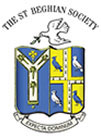|
 |
The Old St Beghian | |
| January 2021 | |||
Colin Reid (FN 43-49) writes:
“My kids seem keen to have me write down memories of my life and I have been recalling my years at St Bees. The thing that perhaps strikes me most is the amount of time we spent running. In our first year we set off at a sprint every time we heard the fag bell. But every day for years we had the morning run before breakfast. At the mid-morning break, if we had committed some misdemeanour, we would have the punishment of doing this morning run five times. This would take about fifteen minutes of our break and we did it at a sustained speed in order to finish before all the cocoa being served in the dining room had run out. Even if we were in time to get any, it was the tepid dregs. How refreshed we were to go back to the classrooms for the second half of the morning’s lessons!
And after lunch what did we do? If we weren’t swimming or playing tennis or fives or squash or rugby or cricket – why, we went running of course: miles and miles along country roads, in gangs of fellow-sufferers from our own houses, with the senior boys at the back yelling at us to keep the pace up. It was an easy day if it was only the Triangle at three-quarters of a mile, although this was done at a sustained sprint. The next longest was the Shore Run, slightly over a mile. After that the runs got more severe. The long drag up to High Walton. The Three Sisters Run starting with the gut-wrenching hill behind Abbey Farm. The days of deep gloom when the notice board condemned us to the Sandwith Run – past the Three Sisters for three miles and three miles back. That wasn’t exercise it was emigration (to quote Private Spike Milligan’s comment on General Montgomery’s fitness regime)! And don’t forget the agony of the junior and senior steeplechase. Just once a year but there were a few training runs beforehand. And do you remember the Standards Cup?
Every boy had to win points for his house by running a standard time for sprints and middle distance running – as well as a standard height for the high jump and the long jump.
And where did we get the energy for all this running? Why from the cordon bleu haute cuisine of course. At breakfast on my first day at St Bees I was faced with a plateful of grey sludge which was reputed to be porridge. It tasted as unappetising as it looked and I, as well as the other new ticks, handed my portion back when the plates were collected. By the time I had had a fortnight of the running regime, I was passing an empty plate for a second helping! We hoovered everything up. The roadkill stew, the frogspawn milk pudding; that lumpy pink blancmange which had the cloying smell of cheap scented soap and a skin like linoleum. We called it ‘Betty Grable’ after a glamorous Hollywood film star of the time, although I never discovered why. The piece de resistance was spotted dick – a long solid roll stretched out on the serving table, which matron hacked into portions – perhaps using a butcher’s cleaver. We reckoned there were miles of it stored in the attic. When I described it to my father, he recognised it immediately. It had been inflicted on him thirty years previously when he was on Foundation, so there must indeed have been miles of it in the attic. It would have been useful as roof insulation. In my father’s day it was called Dead Man’s Leg, a very apt description. Its colour and texture suggested that it could have been made from equal portions of putty and suet, and every two or three feet of its length there appeared a solitary and forlorn-looking date. I have been left with no memory of its taste, which is probably because it had none. It was of course the ideal ballast to have lying in your stomach like a lump of lead if one hour later, you were on the Three Sisters Run.
In later years I was not surprised to learn that the Borstal prisons for young male criminals were modelled on English public schools. If our parents had introduced us to a life of crime at an early age, by the time we were in our teens the state would have been paying for us to have the same education we got at St Bees. I might have used that stratagem for the benefit of my two boys as there was no way I could afford the fees; but as sons of a clergyman they might have found it a bit confusing!”
Home
The St Beghian Society
St Bees School,
St Bees, Cumbria, CA27 0DS.
Tel: (01946) 828093 Email: osb@stbeesschool.co.uk
Web: www.st-beghian-society.co.uk
![]()